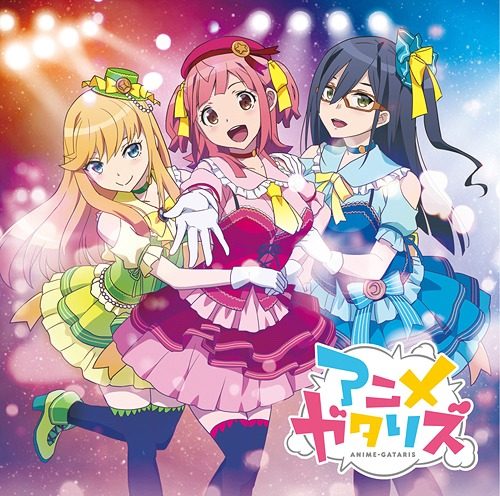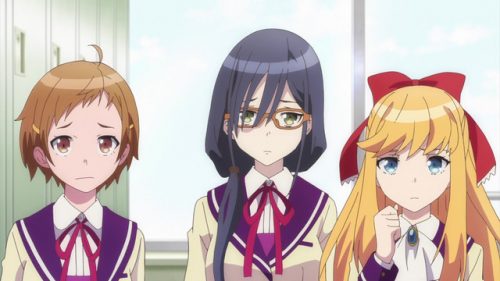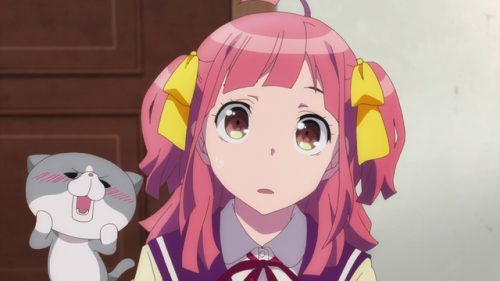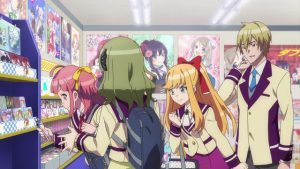
Anime-Gataris is a very fun series with a great twist that pokes fun at the many tropes we find in anime. So, today, we’re going to list the best tropes found in the series and how important they are for the comedy genre in general. Of course, this means that there will be spoilers, so proceed with caution.
10. Beauty Doesn’t Equal Good
This is a fairly new trope, which started out as a subversion of another trope: "Beauty equals goodness". In old tales, it was easy to figure out who was the bad guy by how ugly they were because good people were beautiful and villains were horribly ugly. The easiest way to show this would be Orcs versus Elves, where Elves are unearthly gorgeous where Orcs are so ugly that they can't even understand beauty. If the main character was ugly and not evil in a fairytale, it was because they were cursed and at the end, they turned gorgeous. It wasn't until Cyrano de Bergerac where we started having some heroes who were not exactly pinup models. And in popular culture, this exploded in the eighties when suddenly people who weren't amazingly attractive were the heroes and beautiful characters were either vain idiots or downright evil.
With this in mind, it's not surprising that Kouki Nakano turns out to be quite evil in Anime-Gataris. He’s the most attractive boy in the club—possibly in the whole school, considering that he has fangirls who follow him around. At first, he acts as part of the club and he seems to have a lot of knowledge about anime but around episode 9 his true nature shows and he reveals he's the mastermind behind the future end of the world. Sure, the rest of the club is also very attractive and they are all good, but he is the personification of the "Bishonen” archetype in Anime, meaning that he is the most attractive person in the series.
9. Hammer Space / Butler Space

Everyone who carries a bag or has to pack for a trip knows that we'll always end up forgetting the thing we need the most. That is why hammerspace, popularized in Ranma ½, is such an interesting staple of most anime that is not set completely in a realistic universe. Seeing anime characters pull out things out of nowhere has become quite a mainstay of many series even lampshaded by some characters in-universe. Butler Space is a step up, where servants such as butlers and maids come out of nowhere, with all the equipment needed in order to help their master.
Sebas, Arisu’s Butler, can appear at her side the second she snaps her fingers and no matter where she is, or what she needs, Sebas will always have whatever is important at the moment without asking any questions. Sometimes, he can do it alone, like when it was needed to clean up the anime club classroom he brings an army of maids and absolutely no one except for Minoa questions this.
8. Mean Rich Girl

This one is a bit of subversion in Anime-Gataris too but it’s far too important to the plot to ignore. In pop culture, we are very used to the fact that if a character has more money than the rest of the cast, they're usually bullies who buy friendships and think everyone is less important than them unless they're the main character or the main character's best friend. And in those cases, their wealth tends to be downplayed a lot. But Arisu Kamiigusa is a very curious version of this trope.
When we first meet her, she seems to be the embodiment of the mean rich girl image, given that everyone is in awe of her, she doesn’t even talk to her classmates and she literally shines. Minoa even comments that, before talking about anime to her, she had never seen Arisu smile. And of course, Arisu’s solution to every problem in her life is to simply throw money at it and still is quite mean to those who contradict her, such as when Miko Kouenji insists that light novels are inherently better than their anime counterpart. Just because she is a main character it doesn't mean she can't be mean.
7. Fourth Wall Breaks Easily
The Fourth Wall is a very interesting concept that began in theater: while the audience is watching the “room” where the story happens, there’s an invisible “fourth wall” between them and the actors; the actors (or, in the case of movies and anime series, the characters) “can’t see” the audience at all. Whenever the characters address the audience, they’re breaking the fourth wall and this has been happening more or less since humanity invented theater.
In Animegataris we have two different fourth walls. The one between us and the story, and the one between the characters of the story and the anime they like. Both are incredibly fragile, as we find out in the later episodes when the anime world starts spilling into the Anime-Gataris world to the point that the art-style shifts and at least two characters are revealed to be from the anime dimension and not the “real” world. Not only that but, once Minoa realizes that, she starts talking to her audience and by doing that, she is breaking her own fourth wall.
6. Talking Animals
Talking animals have also been a trope for stories more or less since stories have existed. From ancient myths to modern stories, talking animals are the perfect way to give a lesson to the listeners or an amazing sidekick for the chosen one to save us all. This is only if the story has enough fantasy to allow for a talking animal and thus, they are usually absent from Slice of Life anime like Animegataris.
Which is why Neko-sensei is so noticeable and why we have to talk about him and this trope. At first, when he appears, he only talks to Minoa and we could argue that this means that his voice is her imagination. But soon we realize that not only does Neko-sensei talk, he also has a very good reason not to talk to anyone except her and that is part of a key to understanding the whole plot.
5. Fanservice for All
Fanservice is not necessarily a given in anime. In fact, one could argue that it can take the attention away from great stories if there’s a little too much Gainax bouncing or too many beach episodes in a series. But what makes Anime-Gataris special is that it not only makes use of a lot of traditional fanservice, it also goes out of its way to add other kinds of shout-outs and cameos that can make any otaku smile.
Story aside, if you only want to watch a series for the visuals and the gags, Animegataris has you covered. From Pretty Cure to Love Live!, from Gunbuster to the Melancholy of Haruhi Suzumiya, from Madoka Magica to Dragon Ball, every single episode is crammed full of references. Maybe you won’t get them all, but there’s at least one in there that will make you smile. There’s also a lot of fanservice for the guys, usually in the shape of Yui, and even some for girls, with both Nakano and, surprisingly, Kai once he takes his glasses off.
4. Foreshadowing / Second View Bonus

In a series with a secret twist, foreshadowing is very delicate. They can't be too obvious because that risks giving away the twist too early, and if they're too subtle then the twist seems to come out of nowhere. In Anime-Gataris, there are two kinds of Foreshadowing: the traditional kind that may look like something unimportant but will become significant in the future and a more immediate one in which what was foreshadowed happens mere seconds after it was mentioned. Both are quite entertaining, although the second one is particularly obvious. Examples are how Kai Kai can do very weird things like swearing that he creates barriers and keeps the school safe with no one really commenting on it, or Neko-Sensei growling the second Nakano enters the Club room.
The best part of this is that Animegataris offers a lot of reasons to be rewatched. The first time, little hints may be ignored—like Kai Kai calling Nakano "Aurora" right off the bat—but once you watch it a second time knowing what the final twist is, those small hints give every character a new depth. Not only that, once you know the ending, you can distract yourself a bit from the characters’ dialogue and look for subtle clues in the background, and there are many to discover through a second or even a third time rewatching the whole series.
3. Anime is Serious Business
This particular trope is not exclusive to anime, as it refers more to something that can be a simple hobby in real life but, in the story, becomes a matter of life or death. For example, card games like Magic are for fun in our world, but in Yu Gi-Oh they literally determine the future of big business. This usually applies to board games or sports anime where the titular sport is suddenly the most important thing in the world. As a more extreme example; in Yakitate Japan!, bread baking becomes the literal way to save the world from global warming and can even let people travel in time.
Because Animegataris is the story of an anime club, it shouldn’t be a surprise that all the members, except for Minoa who is still learning about it, take it incredibly seriously. But as the series advances, others start taking anime very seriously too, until it’s revealed that the anime club antics can very well end the world. It’s then that things get really bizarre as only the knowledge of different anime tropes can save everyone.
2. Cloudcuckoolanders Rule the World

There are characters that live in a world of their own. They seem to always have their heads in the clouds, away from the reality where everyone else lives. In most anime series, they are the comic relief; that one character that only holds the limelight for a little while and eases the tension in otherwise dark scenes. But, sometimes, there are anime series where the cast is completely made out of crazy people, each of whom lives in their own personal reality, to the point that they don't even notice when reality starts blending with the anime world.
What makes this even more interesting is that, at first, everyone except Kai-Kai is presented as a very normal person: sure, they like anime, but it’s not as if they’re talking about invisible barriers and books that can’t be touched without proper precautions. But that doesn’t mean they don’t have particular quirks that make them seem a bit out there, or that they get a bit worse with every episode as they stop acting like real people start becoming “real” anime characters.
1. The All-Powerful, All-Knowing Student Council

If an anime is set in a high school, chances are that, sooner or later, we’re going to meet the student council. Most of the time, they're going to be students from third grade, especially if the main characters are freshmen, and they all are going to be considered both perfect and terrifying by the general student population. More importantly, they tend to have an absolute authority over the school, sometimes even above the Principal and other adults. Some student councils can even invent their own rules and can even use their power to try to conquer the world. While, in Japan, real student councils have more authority than their Western counterparts, as they are in charge of clubs funding, it still gets exaggerated to an absurd level.
The student council in Anime-Gataris makes their appearance on the second episode just as the club manages to get their sixth member. At the exact moment they get him and would become an official club, the three members of the student council enter the room and inform the anime club that, starting then, they are forbidden from using the room for their club activities. How did they know that the club was forming? Possibly by the flyers Minoa and Arisu were handing out to other students. But how do they know that Nanako had just come to join in? It’s never explained. How did they find out that the anime club was connected to the world going crazy? We never know either. It’s part of the mystery and the power of the student council.
Final Thoughts
Tropes are sometimes considered cliché because they’re very widely used. But they aren’t bad, an amazing story can be full of tropes and, if they’re well used, they can surprise even the most jaded viewer. It takes good writers to take the tropes, use them correctly, and even subvert them to entertain and surprise the viewers.
Which tropes have you identified in Animegataris? Which ones are your favorites? Which ones do you think didn’t get used to their full potentials? Which ones did they use perfectly? This is a conversation, so please, let us know in the comments below.
Recommended Post
Top 10 Otaku Moments in Animegataris
Recommended Post





